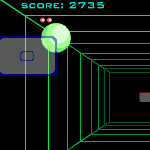3D PONG GAME TO PLAY FREE ONLINE |
||||
|
||||
|
3D
Pong Game - A Virtual 3D Ping Pong A 3D pong game that combines the best features of squash and tennis. The game space is a cubic room with virtual walls. The back wall is defended by the computer - your opponent - and the front wall (screen) is defended by you. The aim of the game is to make the ball hit the back wall defended by the computer and avoid coming balls from hitting the front wall of the game cube with the square racket controlled by the mouse. The ball's trajectory depends on the position and velocity of either racket at the moment it strikes the ball, i.e. the racket lets you skew and curve the shots. The ball may touch the side walls of the cube, which can change its trajectory. A thin white frame moves along the side walls with the ball so you can feel its 3d spatial position easily. There is no gravity in the game; all four side walls (left, right, up and down) are equivalent. When your computer opponent misses the ball, so it hits the back side of the cube outside your opponent's racket, you win. If you miss the ball and it hits the front side of the cube, the screen) you lose. The Old Gameplay
Author: Flash Games |
||||
